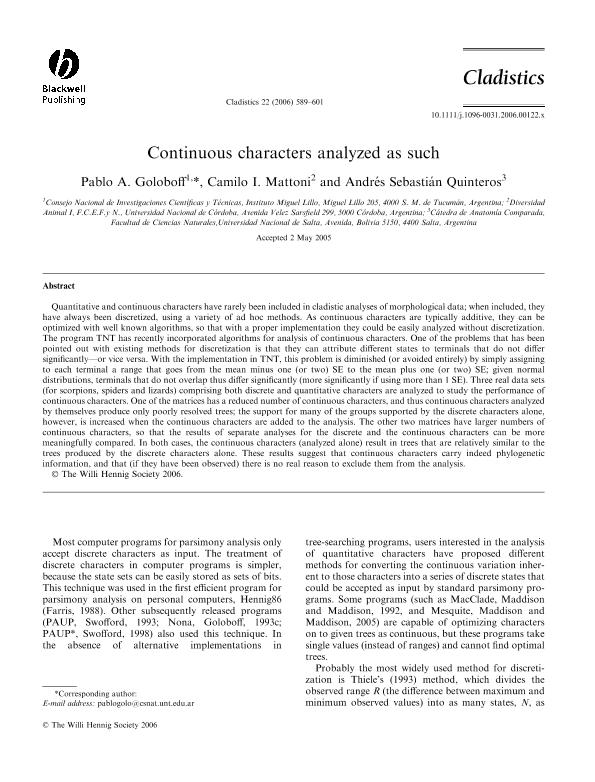Mostrar el registro sencillo del ítem
dc.contributor.author
Goloboff, Pablo Augusto

dc.contributor.author
Mattoni, Camilo Ivan

dc.contributor.author
Quinteros, Andres Sebastian

dc.date.available
2019-05-28T14:29:45Z
dc.date.issued
2006-12
dc.identifier.citation
Goloboff, Pablo Augusto; Mattoni, Camilo Ivan; Quinteros, Andres Sebastian; Continuous characters analyzed as such; Wiley Blackwell Publishing, Inc; Cladistics; 22; 6; 12-2006; 589-601
dc.identifier.issn
0748-3007
dc.identifier.uri
http://hdl.handle.net/11336/77309
dc.description.abstract
Quantitative and continuous characters have rarely been included in cladistic analyses of morphological data; when included, they have always been discretized, using a variety of ad hoc methods. As continuous characters are typically additive, they can be optimized with well known algorithms, so that with a proper implementation they could be easily analyzed without discretization. The program TNT has recently incorporated algorithms for analysis of continuous characters. One of the problems that has been pointed out with existing methods for discretization is that they can attribute different states to terminals that do not differ significantly—or vice versa. With the implementation in TNT, this problem is diminished (or avoided entirely) by simply assigning to each terminal a range that goes from the mean minus one (or two) SE to the mean plus one (or two) SE; given normal distributions, terminals that do not overlap thus differ significantly (more significantly if using more than 1 SE). Three real data sets (for scorpions, spiders and lizards) comprising both discrete and quantitative characters are analyzed to study the performance of continuous characters. One of the matrices has a reduced number of continuous characters, and thus continuous characters analyzed by themselves produce only poorly resolved trees; the support for many of the groups supported by the discrete characters alone, however, is increased when the continuous characters are added to the analysis. The other two matrices have larger numbers of continuous characters, so that the results of separate analyses for the discrete and the continuous characters can be more meaningfully compared. In both cases, the continuous characters (analyzed alone) result in trees that are relatively similar to the trees produced by the discrete characters alone. These results suggest that continuous characters carry indeed phylogenetic information, and that (if they have been observed) there is no real reason to exclude them from the analysis.
dc.format
application/pdf
dc.language.iso
eng
dc.publisher
Wiley Blackwell Publishing, Inc

dc.rights
info:eu-repo/semantics/openAccess
dc.rights.uri
https://creativecommons.org/licenses/by-nc-sa/2.5/ar/
dc.subject
Phylogeny
dc.subject
Continuous Character
dc.subject.classification
Otras Ciencias Biológicas

dc.subject.classification
Ciencias Biológicas

dc.subject.classification
CIENCIAS NATURALES Y EXACTAS

dc.title
Continuous characters analyzed as such
dc.type
info:eu-repo/semantics/article
dc.type
info:ar-repo/semantics/artículo
dc.type
info:eu-repo/semantics/publishedVersion
dc.date.updated
2019-05-23T17:42:32Z
dc.journal.volume
22
dc.journal.number
6
dc.journal.pagination
589-601
dc.journal.pais
Reino Unido

dc.journal.ciudad
Londres
dc.description.fil
Fil: Goloboff, Pablo Augusto. Consejo Nacional de Investigaciones Científicas y Técnicas. Centro Científico Tecnológico - Tucumán. Unidad Ejecutora Lillo; Argentina
dc.description.fil
Fil: Mattoni, Camilo Ivan. Consejo Nacional de Investigaciones Científicas y Técnicas. Centro Científico Tecnológico Conicet - Córdoba; Argentina
dc.description.fil
Fil: Quinteros, Andres Sebastian. Consejo Nacional de Investigaciones Científicas y Técnicas. Centro Científico Tecnológico Conicet - Salta. Instituto de Bio y Geociencias del NOA. Universidad Nacional de Salta. Facultad de Ciencias Naturales. Museo de Ciencias Naturales. Instituto de Bio y Geociencias del NOA; Argentina
dc.journal.title
Cladistics

dc.relation.alternativeid
info:eu-repo/semantics/altIdentifier/doi/https://dx.doi.org/10.1111/j.1096-0031.2006.00122.x
dc.relation.alternativeid
info:eu-repo/semantics/altIdentifier/url/https://onlinelibrary.wiley.com/doi/abs/10.1111/j.1096-0031.2006.00122.x
Archivos asociados
